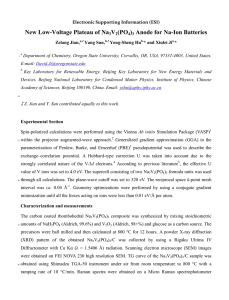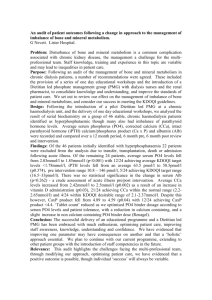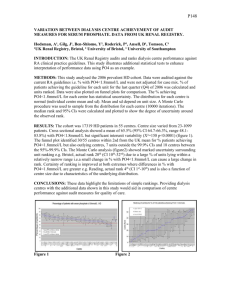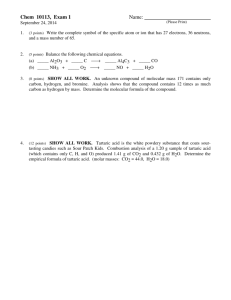Simulations of Li ion diffusion in the electrolyte material – Li PO
advertisement
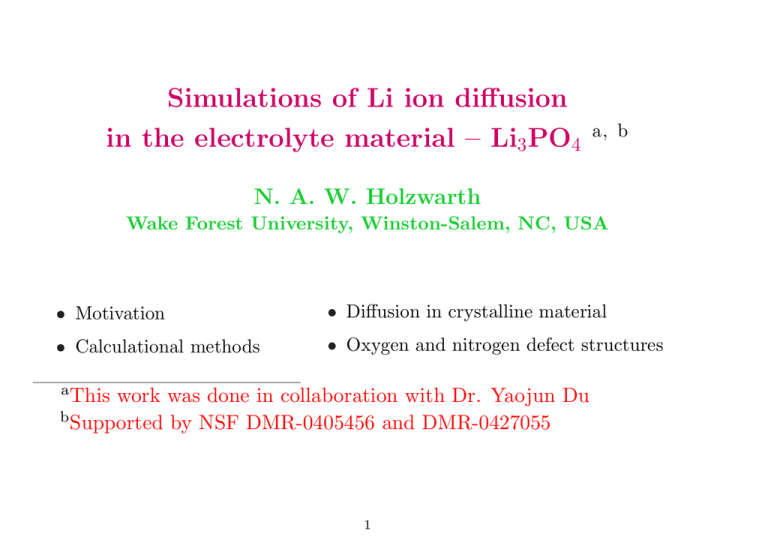
Simulations of Li ion diffusion
in the electrolyte material – Li3 PO4
a, b
N. A. W. Holzwarth
Wake Forest University, Winston-Salem, NC, USA
• Motivation
• Diffusion in crystalline material
• Calculational methods
• Oxygen and nitrogen defect structures
a This
work was done in collaboration with Dr. Yaojun Du
b Supported by NSF DMR-0405456 and DMR-0427055
1
Diagram of discharge operation for a Li-ion
battery
Li+
−
+
Cathode Electrolyte Anode
−
e
V = IR
I
2
LiPON (Li3 PO4 + N) developed at ORNL
Properties
• Chemical and structural stability.
• Reasonable Li+ conductivity.
• Stable contacts with anodes and cathodes.
3
Questions
1. What is the basic mechanism for Li+ transport in crystalline Li3 PO4 ?
• Migration of Li+ vacancies?
• Migration of Li+ interstitials?
2. What are the effects of O and N defects? Neutral materials have
stoichiometries: Li3+x PO4−y Nz , with x = 3z − 2y.
• Stable defect structures.
• Effects on Li+ migration.
4
Summary of “first-principles” calculational
methods
Basic approximations
• All calculations are carried out using supercells composed of 16 Li3 PO4 units.
• Nuclear motions are assumed to be separable from the electronic motions within the
Born-Oppenheimer approximation and are treated classically.
• Electronic effects are treated within density functional theory (DFT) using the local
density approximation (LDA) form of the exchange-correlation functional. (A few results
were obtained using the generalized gradient approximation (GGA) form.) These
calculations give us the total energies corresponding to the electronic ground state
E({Ra }) corresponding to the nuclear coordinates {Ra } and with corresponding
self-consistent electron density ρ(r, {Ra }).
• Meta-stable configurations are determined by minimizing the total energies and converging
the forces (|∇a E({Ra })| < 0.01 eV/Å).
• Migration energies Em between adjacent metal-stable configurations are determined using
the Nudged Elastic Band method within an estimated error of ±0.05 eV.
5
Codes for electronic structure calculations
Method
Comments
PAW
pwpaw - pwpaw.wfu.edu
socorro - dft.sandia.gov/socorro
abinit - www.abinit.org
Works well for moderately large unit cells,
but variable unit cell optimization not yet implemented in pwpaw and socorro. Need to
construct and test PAW basis and projector
functions.
LAPW
wien2k - www.wien2k.at
Works well for smaller unit cells; variable unit
cell optimization not implemented. Need to
choose non-overlapping muffin tin radii and
avoid “ghost” solutions.
PWscf
pwscf - www.pwscf.org
Works well for large unit cells and includes
variable unit cell optimization. Need to construct and test soft pseudopotential functions.
6
Secret recipe for pseudopotential construction
rc (bohr)
Atomic basis
Li
PAW∗
1.61
1s, 2s, 2p
PWscf†
1.60
1s, 2s, 2p
LAPW
1.70
1s, ²s, ²p
PAW∗
1.41
2s, ²s, 2p, ²p
PWscf†
1.40
2s, ²s, 2p, ²p
LAPW
1.28
2s, ²s, ²p
PAW∗
1.51
2s, 3s, 2p, 3p
PWscf†
1.50
3s, ²s, 3p, ²p, ²d
LAPW
1.38
²s, 2p, ²p
O
P
∗
†
PAW basis and projector functions generated by atompaw code.
Ultra-soft pseudopotentials generated by uspp code of David Vanderbilt.
7
Test results for simple oxides
Li2O
0.5
LDA
∆E (eV)
∆E (eV)
GGA
PWscf
PAW
LAPW
0.8
0.4
0.1
0.2
8.5
9
0
9.5
PWscf
PAW
LAPW
GGA
PWscf
PAW
LAPW
0.6
0.2
0
8
LDA
1
PWscf
PAW
LAPW
0.4
0.3
PO4
1.2
2.8
2.9
3
3.1
b (bohr)
a (bohr)
Fluorite structure
Tetrahedral molecule
8
Validation of calculations –
comparison with Raman spectral data
Exp. A
Exp. B
Exp. C
Exp.
Exp. D
LDA
LDA
GGA
GGA
200
400
600
-1
ν (cm )
800
1000
200
400
600
-1
ν (cm )
800
1000
γ-Li3 PO4
β-Li3 PO4
Exp. A – (RT) – Mavrin & co-workers, JETP 96, 53 (2003);
Exp. B – (RT) – Harbach & co-workers, Phys. Stat. Sol. B
66, 237 (1974); Exp. C – (LNT) – Harbach; Exp. D – (LNT)
Popović & co-workers, J. Raman Spec. 34 77, (2003)
Exp. – (LNT) Popović & co-workers, J. Raman Spec. 34 77,
(2003)
9
Ionic conductivity via activated hopping
Schematic diagram of minimal energy path
Arrhenius relation
Approximated using NEB algorithma
– “Nudged Elastic Band”
σ · T = Ke−EA /kT
From: Ivanov-Shitz and co-workers,
Cryst. Reports 46, 864 (2001):
Em
a
EA = 1.14, 1.23, 1.14, 1.31, 1.24 eV for
1,2,3,4,5, respectively.
Henkelman and Jónsson, JCP 113, 9978 (2000)
10
Crystalline Li3 PO4
γ
β
7
7
1
43
5
2
6
8
2c
3
5
2
4
2c
6
1
2a
2b
a
2b
Ball and stick drawing of the equilibrium structures of the γ-Li3 PO4 and β-Li3 PO4 supercells
used in the simulations. The PO4 groups are indicated with bonded yellow and blue spheres.
Li ions are indicated by light and dark gray spheres representing the crystallographically
distinct sites. The number labels on some of the Li sites are used to describe vacancy diffusion.
11
Example of configuration coordinate diagrams for
vacancy diffusion in Li3 PO4
1
0.8
0.6
0.4
0.2
1(d)
β
b-axis
Energy (eV)
Energy (eV)
γ
LDA
GGA
4(d)
5(d)
0.8
0.6
0.4
0.2
4(b)
12
a -axis
3(b)
5(b)
Summary of vacancy diffusion steps in γ-Li3 PO4
and β-Li3 PO4 .
Axis
Step
Distance
Em
(Å)
(eV)
Axis
b
c
Distance
Em
(Å)
(eV)
1(b) ↔ 2(a)
2.94
0.51
β-Li3 PO4
γ-Li3 PO4
a
Step
b
1(d) ↔ 2(c)
2.91
0.43
2(c) ↔ 3(d)
3.10
0.66
2(a) ↔ 3(b)
3.03
0.55
1(d) ↔ 2(c) ↔ 3(d)
5.19
0.66
1(b) ↔ 2(a) ↔ 3(b)
5.15
0.55
1(d) ↔ 4(d)
2.98
0.43
4(b) ↔ 3(b)
2.97
0.56
4(d) ↔ 5(d)
3.03
0.74
3(b) ↔ 5(b)
3.04
0.72
1(d) ↔ 4(d) ↔ 5(d)
6.01
0.74
4(b) ↔ 3(b) ↔ 5(b)
6.01
0.72
4(d) ↔ 8(d)
2.97
0.62
6(b) ↔ 5(b)
2.96
0.71
4(d) ↔ 8(d) ↔ 7(d)
4.84
0.62
6(b) ↔ 5(b) ↔ 7(b)
4.76
0.71
4(d) ↔ 6(c)
3.41
0.57
6(b) ↔ 2(a)
2.93
0.71
6(c) ↔ 7(d)
2.60
0.68
2(a) ↔ 7(b)
2.94
0.61
4(d) ↔ 6(c) ↔ 7(d)
4.84
0.68
6(b) ↔ 2(a) ↔ 7(b)
4.76
0.71
13
a
c
Metastable interstitial Li+ configurations in
γ-Li3 PO4
I channel
II channel
2b
2b
II
I
2c
2c
a
a
Ball and stick drawing of the metastable interstitial Li+ sites (indicated with green balls) in
γ-Li3 PO4 . Similar structures occur in β-Li3 PO4 .
14
Example of configuration coordinate diagrams for
interstitial diffusion in Li3 PO4
0.5
b & c axes
0.4
0.3
0.2
0.1
0
I0
β
LDA
GGA
Energy (eV)
Energy (eV)
γ
I0
0.5 a & c axes
0.4
0.3
0.2
0.1
0I
0
15
I0
Summary of interstitial diffusion steps in
γ-Li3 PO4 and β-Li3 PO4 .
Type
Step
Distance
Em
(Å)
(eV)
γ-Li3 PO4
interstitialcy
I0 ↔ I0
4.0
0.29
interstitialcy
I0 ↔ II0
3.3
0.30
direct hop
II0 ↔ II ∗
0.5
0.14
I0 ↔ II0 ↔ II ∗ ↔ II0 ↔ I0
7.0
0.44
β-Li3 PO4
interstitialcy
I0 ↔ I0
3.9
0.39
interstitialcy
I0 ↔ II0
3.5
0.53
direct hop
II0 ↔ II1
0.5
0.05
interstitialcy
II1 ↔ I0
2.5
0.52
I0 ↔ II0 ↔ II1 ↔ I0
6.0
0.53
16
Illustration of interstitialcy mechanism
along b & c axes in γ-Li3 PO4
17
Illustration of interstitialcy mechanism
along b & c axes in γ-Li3 PO4
18
Illustration of interstitialcy mechanism
along b & c axes in γ-Li3 PO4
19
Illustration of interstitialcy mechanism
along b & c axes in γ-Li3 PO4
20
Illustration of interstitialcy mechanism
along b & c axes in γ-Li3 PO4
21
Illustration of interstitialcy mechanism
along b & c axes in γ-Li3 PO4
22
Illustration of interstitialcy mechanism
along b & c axes in γ-Li3 PO4
23
Illustration of interstitialcy mechanism
along b & c axes in γ-Li3 PO4
24
Illustration of interstitialcy mechanism
along b & c axes in γ-Li3 PO4
25
Comparison with experimental measurements of
activation energies in crystalline Li3 PO4
By definition, in a perfect crystal no vacancies or
interstitial ions can exist, so that mobile species
such as vacancies and interstitials must first be
created before ion diffusion can occur. In real
crystals, intrinsic defects (vacancy-interstitial
pairs) are created thermally with a formation
energy Ef and the measured activation energy
Estimated minimum migration, formation, and
activation energies (in eV) compared with
temperature coefficient of ionic conductivity in
single crystals (Ivanov-Shitz and co-workers,
Cryst. Reports 46, 864 (2001)
Direction
Ef
Em
EA
EA (exp)
0.44
1.3
1.23
0.29
1.1
1.14
0.29
1.1
1.14
γ-Li3 PO4
is given by EA = Em + Ef /2 . Assuming
thermal equilibrium between the number of
vacancy and interstitial defects compared with
the number of unvacant lattice sites and
unoccupied interstitial sites, the concentration
(n) of vacancies and interstitials is determined
by a Boltzmann factor n2 ∝ e−Ef /kT . Thus the
Arrhenius equation takes the form
σ · T = K 0 ne−Em /kT ≡ K 0 e−(Em +Ef /2)/kT .
a
b
1.7
c
β-Li3 PO4
b
a
c
26
}
}
2.1
0.53
1.6
0.39
1.4
0.39
1.4
Defect structures – γ-Li3− 161 PO4− 162 N 161
Stable “bent” P−N−P structure
7
8
6
2c
54
2
3
1
2b
a
Ideal supercell
Relaxed structure
27
Defect structures – γ-Li3− 161 PO4− 162 N 161
Stable “bent” P−N−P and P−O−P structures
Contours of electron density
Contours of electron density
for “bent” P−N−P structure
for “bent” P−O−P structure
28
Defect structures – γ-Li3− 161 PO4− 162 N 161
Stable “straight” P−N−P structure
7
2c
6
5
4
2
1
3
2b
a
Ideal supercell
Relaxed structure
29
Defect structures – γ-Li3− 161 PO4− 162 N 161
Stable “straight” P−N−P and P−O−P structures
Contours of electron density
Contours of electron density
for “straight” P−N−P structure
for “straight” P−O−P structure
30
Summary of properties of defect structures in
γ-Li3 PO4 .
Bond lengths, angles, and relative supercell energies for P−N−P and P−O−P
structures.
∗
Type
Bond lengths (Å)∗
Bond angle
Energy (eV)
P−N−P (bent)
1.63, 1.66
118(o )
0.00
P−N−P (straight)
1.63, 1.62
174(o )
0.05
P−O−P (bent)
1.66, 1.70
122(o )
2.71
P−O−P (straight)
1.69, 1.66
171(o )
2.59
For comparison, tetrahedral P−O bonds are calculated to be 1.54-1.57 Å.
31
Summary
1. What is the basic mechanism for Li+ transport in crystalline Li3 PO4 ?
• Migration of Li+ vacancies?
Em ≈ 0.6 − 0.7 eV
⇒
• Migration of Li interstitials?
⇒ E ≈ 0.3 − 0.5 eV
• Activation energy for crystalline Li PO
⇒ E = E + E /2 ≈ 1.1 − 1.6 eV.
+
m
3
A
m
4
f
2. What are the effects of O and N defects? Neutral materials have stoichiometries:
Li3+x PO4−y Nz , with x = 3z − 2y. So far we have studied z = 2y = −x = 1/16.
• Stable defect structures
O vacancies cause rebonding of phosphate groups to form bent and straight
P−N−P and P−O−P structures.
⇒
Further work
• Study effects of defects on Li+ migration.
• Study other defect structures, such as x = y = z and their effects on interstitial Li+
migration.
• Simulate properties of glassy structures.
32

